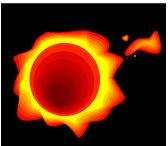Hey, we are now just three days away from the actual launch date to the Red Bull Stratos Mission! If you are wondering what this is all about, please read my previous blog post here.
 |
| Red Bull Stratos - Manned Flight Two. Photo Credit to Red Bull Content Pool. |
Today, I'm going to share exclusive insights on how the Red Bull Stratos team prepare for the jump in terms of the weather forecast. A lot of work definitely has to be done beforehand. One of the most unpredictable factor that will affect the success of the Red Bull Stratos Mission is none other than the weather.
 |
| Red Bull Stratos - Location - Roswell |
Red Bull Stratos meteorologist, Don Day have to examines both the historical and current weather profiles every single minutes because factors like the condition of the wind, precipitation, cloud cover or solar flares all directly impact the ability to launch. So using computer weather models to predict conditions up to 130,000 feet, he can creates flight and landing trajectory projections and able to advise the team about the final launch.
Clip explained how the Red Bull Stratos team derive at the weather forecasts and also the different points where Felix will be met with shockwaves and the dangers that he will face during the last 35 secs of the jump.
To verify all these factors, Don and his team release balloons to assess the conditions above Roswel, New Mexico. Also, they receive data on upper-level conditions from balloons that are launched twice daily at EI Paso, Texas, and Albuquerque, New Mexico. Even by doing so, these conditions can change anytime unexpectedly before take-off or during the mission itself. Thus, the Mission Control Team will receive meteorological readings throughout the whole mission and keep Felix informed to ensure a safe flight.
*********************************************
Different factors of the weather
( All Information extracted from Red Bull Content Pool: Red Bull Stratos Weather Factsheet)
Wind
The wind must be calm. Susceptibility to wind variation increases with balloon size and the Red Bull Stratos balloon is massive. Further, the balloon is only .0008 inches thick (10 times thinner than a sandwich bag). Even before takeoff, the 55-story-high envelope could tear if caught by a wind gust or overturn the mega-ton crane that positions the capsule for launch. Take-off will not be authorized if winds exceed 2 miles per hour from ground level through to several hundred feet in altitude. The team will assess winds throughout the mission – especially at the border of the stratosphere, where turbulence is common. Also, because the balloon will be steered using wind currents, determining wind patterns aloft will enable the team to predict the landing zone even before launch.
Precipitation
Precipitation – whether in the form of snow, ice, rain or heavy fog – could impair visibility for the team and the performance of the balloon. Precipitation of any kind, or even excess humidity, will prevent a launch. Excessive frost or ice build-up on the balloon could impede takeoff or ascent by adding potentially hundreds of pounds to the weight of the payload.
Cloud Cover
To comply with U.S. Federal Aviation Administration regulations, the Red Bull Stratos balloon will not fly if skies are more than 5/10 (half) overcast or if the horizontal visibility at any point is less than 3 miles. Clear skies will enable better tracking of the capsule’s ascent and Felix Baumgartner’s descent, and will provide Felix with the best possible conditions for orienting himself in the sky.
Solar Flares

.JPG)




No comments:
Post a Comment